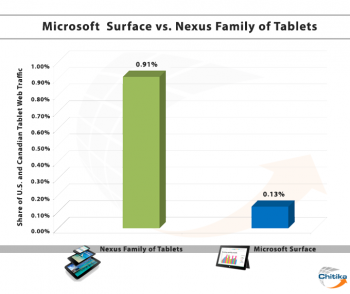
Chitika: Nexus tablets make up less than 1% of web traffic
As hot as Google’s tablets have been since the Nexus 7 launched earlier this year you’d think they were in the hands of pretty much everyone under the sun. Well, Chitika’s latest web traffic report, where they compared traffic between Google’s Nexus tablets and the Microsoft surface for a period of 7 days in November, says Google’s tablets are barely making a dent in web traffic. In fact, the Nexus 7 and Nexus 10 make up for less than 1% combined. How could this be?
Well, demand for Google’s products are seemingly high with the way delays have been going, but there is always the issue of relativity to consider. Demand looks like it’s through the roof because Google had problems meeting supply at one point, but perhaps supply was extremely low in the first place. No one knows how many units of the Nexus devices Google has sold thus far, really.
The Nexus 7’s supply/demand struggle leveled out quite some time ago, and it looks like the Nexus 10 is beginning to level out as well. If web traffic is still this low after the dust has settled then it implies the Nexus devices aren’t quite as hot as we’d be led to believe. There are a ton of variables to consider, of course.
For starters, Chitika is only one research firm, albeit a very significant one in the mobile advertising space. There’s also the aforementioned issue of not knowing Google’s exact shipment numbers. There’s little doubt that the Nexus tablets are hot within the techie crowd, but it appears it’s still a mere tadpole in the sea up against the rest of the crop (particularly Apple’s iPad).
For comparison’s sake, Chitika also showed where the Microsoft Surface resided for web traffic. It accounts for just .13%, a very minuscule amount even compared to the Nexus devices’ .91%. Again, slick marketing and a hush-mouth operation for shipment numbers would have Microsoft leading folks to believe that it’s happy with market penetration of its first Windows RT tablet, but third party analytics such as the kind Chitika provide tell the more accurate story in the absence of official numbers.
Long story short, if your name isn’t “Apple” then you probably aren’t enjoying a healthy market share in the tablet space right now. The iPad Mini surely helped fend the competition off even more effectively with its more attractive price point.
It would be interesting to see where other OEMs’ devices end up on the scale, such as the Amazon Kindle Fire or Samsung’s line of tablets. These enjoy more robust marketing campaigns so perhaps they’re faring a lot better in the overall scheme of things. We won’t have a clearer picture on a lot of that until early 2013 when the Q4’2012 reports are out, but we wouldn’t expect more than 10% of market share between Google’s Android and Microsoft’s Windows combined. We could be wrong, and you’d better believe we hope we’re wrong, but only time will tell.
[via WinSource]